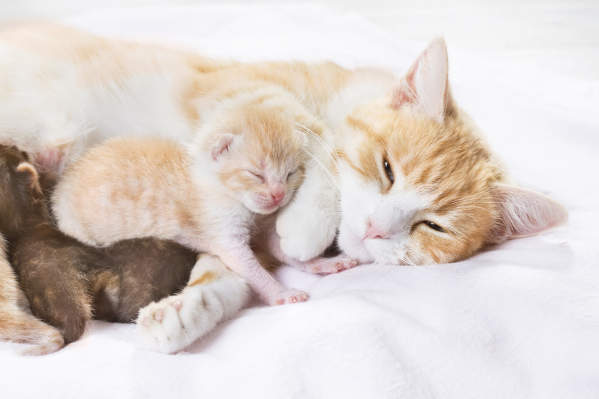If you're welcoming a new kitten home and are already the proud parent of a cat, you likely have questions about how to best introduce your two feline friends.
No matter how sweet and loving your cats are, this process needs to be done carefully to create a healthy and affectionate relationship and avoid hostility and unfriendly competition. That’s why it's essential that pet parents learn how to correctly introduce a new kitten to cats.
Here's what you need to know so your resident cat and your new kitten are the best of friends—or at least not enemies.
Will my cat accept a new kitten?
Taking the time to properly introduce your furry friends can significantly boost the chances that your kitten will be accepted by your cat.
Because of cats’ tendency to be territorial, it’s essential that you give your cats space and time to get adjusted to one another. What we don't recommend doing is putting your two cats together and simply leaving them to figure out the relationship on their own.
How do I introduce my cat to a new kitten?
While properly introducing your new kitten to your cat can take patience and commitment, being thoughtful about the process can go a long way.
Pick a room for your kitten
To begin, place your resident cat in a room with the door closed before you bring the new kitten home. You'll want take your kitten to a different room so they won't see the cat or any other animals that are in your house.
Once you get your kitten to their room, you can securely shut the door and visit with your other cat. Your resident cat will be able to smell the new kitten’s scent on you and will immediately be aware of the new feline in the home.
When you pet your cat, you can provide them with treats to positively reinforce the experience.
Scent swap
Pet parents can start swapping the new kitten's bedding with the bedding of the resident cat. This will help your kitten get acclimated to the other cat’s smell, and vice versa.
Read: The 14 Best Cat Beds Of 2022, For Every Type Of Sleeper
You can also start rotating rooms every few days. That way, your new kitten will have the opportunity to explore other areas of your home and your resident cat will have the opportunity to spend time in the new kitten’s room, getting used to their smell.
It's important to give both cats equal attention and playtime during this phase, and the more you can set up a routine, the better.
Once your cat and kitten get desensitized to the smell and sound of the other feline, you can starting exposing them to each other by sight.
Introduce visual contact
One way to achieve a successful visual introduction is to put the new kitten in a carrier to meet the new cat. Place it on the floor and let the resident cat sniff. You can also leave a baby or pet gate between rooms and allow them to greet each other on opposite sides of this barrier. Let them meet like this a few times a day.
Continue this step for a few days until they get acclimated to one another.
Try short, supervised meetings
Let your cat and kitten meet for a short period of time in a supervised setting. You can gradually increase how long these visits are by a few minutes each day.
If it seems like the cats are getting scared or anxious, give them a break and keep them separated temporarily. Proceed with the short meetings slowly.
Read: Why Do Cats Hiss At New Kittens Or Cats?
Graduate to short, unsupervised meetings
Once you are confident that there is no aggression between the new kitten and your resident cat, they can finally graduate to brief, unsupervised meetings.
This could take a while depending on your cats' personalities, so remember to have patience.
Will my cat hurt my new kitten?
It's possible that there will be some aggression between your new kitten and your cat. This largely depends on your cats' personalities, disposition, and behavior, as well as how carefully you introduce them.
It can be helpful to tune into your cat’s body language to figure out how your cat or kitten is feeling. If you see swatting, biting, hissing, chasing, or ambushing, it's a sign that they're not ready to be alone together.
Until you're confident that your cats are comfortable together, you should supervise them carefully.
How long does it take for a cat to get used to a new kitten?
It’s difficult to create a timeline for how long it will take for a cat to get used to having a new kitten in the house. For some cats, it could take a few days, and in other cases, it could take several weeks or months.
According to Pawp veterinarian Dr. Laura Robinson, don’t expect this to be a quick adjustment.
“It can take up to a couple of months for cats to get used to a new kitten,” she shares. “I recommend slowly introducing for just 10-15 minutes a day for the first few days, then slowly increasing the amount of time. You can also trade blankets between the cats, so they get used to each other's scent without actually physically being around them.”
Dr. Robinson also suggests using an over-the-counter pheromone plug-in device that emits scents designed to help cats adapt to changes in their environment.
Have a question about your kitten?
Pawp vets are available to answer any questions that you might have regarding your cat's needs or wellbeing. There is never a wait or appointment necessary.
SOURCES:
Introducing Your New Cat to Your Other Household Cats | UCDavis
Feline Behavior Problems: Aggression | Cornell
Seven personality and behavior traits identified in cats | ScienceDaily
